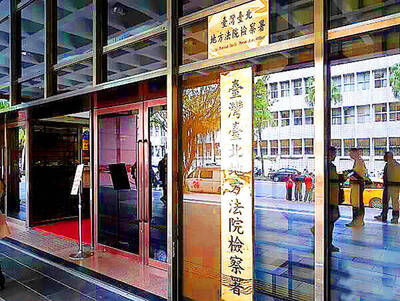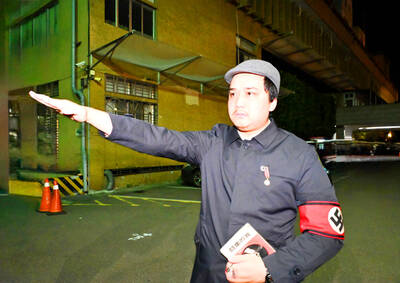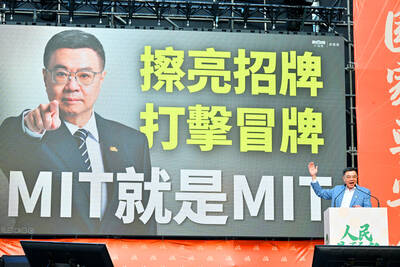Japan yesterday approved a plan to develop with the US a next-generation shipborne missile defense system, amid growing concern about North Korea and rising tension between Japan and China.
The government decided to launch development of the system in the financial year starting in March next year. It is based on the US sea-based Standard Missile 3 (SM-3) after six years of joint research.
"The missile defense system is purely and solely defensive in nature to protect the lives and assets of the people," Chief Cabinet Secretary Shinzo Abe said in a statement after the decision.
"It is appropriate to proceed with the joint development in order to secure the capability to deal with the threat of ballistic missiles," he said, despite lingering doubts about the precision of such a system.
Japan has been in a hurry to build a missile defense system with the US since North Korea stunned the world in 1998 by firing a missile over the Japanese mainland into the Pacific.
Analysts say North Korea is developing long-range missiles capable of reaching Alaska, Hawaii and perhaps the US West Coast.
Japan's Defense Agency said earlier this month that the US and Japanese militaries are looking at a site in Aomori, about 580km northeast of Tokyo, to base a radar system for the missile shield. The high-resolution radar is expected to be able to discriminate targets from decoys.
The Cabinet of Prime Minister Junichiro Koizumi approved a ?3 billion (US$2.5 million) budget for the next financial year for development costs as requested by the Defense Agency.
It also earmarked ?700 million for remaining work on the joint research.
Abe, the top government spokesman, said that the joint missile project would be carried out without infringing on Japan's strict control on exports of arms.
The SM-3 is part of an anti-missile shield which includes the land-based surface-to-air PAC-3.
SM-3s intercept ballistic missiles when they reach their highest point outside of the atmosphere and PAC-3 missiles are used to destroy missiles that evade SM-3 interceptions.
The SM-3 interceptors will be based on destroyers equipped with the state-of-the-art Aegis air-defense system.
Fukushiro Nukaga, the state minister for defense, said last week Japan would shoulder about US$1 billion to US$1.2 billion of the cost of the nine-year project. The US side is expected to chip in US$1.1 billion to US$1.5 billion dollars.
"The system will contribute to stability in the region as it will strengthen our country's defense capability ... amid the proliferation of ballistic missiles," he told reporters yesterday.
"We hope to spare no effort in explaining the purpose of the [missile] policy pursued by Japan and the US," he added.
The missile-defense project has been a major part of the strengthened Japan-US military alliance in recent years and is excluded from Japan's ban on arms exports.
In 1967, Japan banned exports of weapons to the Communist bloc, countries under UN sanctions and those in international conflicts. The government tightened the ban in 1976 preventing all arms exports regardless of destination. But transfer of military technology to the US was made an exception.

INVESTIGATION: The case is the latest instance of a DPP figure being implicated in an espionage network accused of allegedly leaking information to Chinese intelligence Democratic Progressive Party (DPP) member Ho Jen-chieh (何仁傑) was detained and held incommunicado yesterday on suspicion of spying for China during his tenure as assistant to then-minister of foreign affairs Joseph Wu (吳釗燮). The Taipei District Prosecutors’ Office said Ho was implicated during its investigation into alleged spying activities by former Presidential Office consultant Wu Shang-yu (吳尚雨). Prosecutors said there is reason to believe Ho breached the National Security Act (國家安全法) by leaking classified Ministry of Foreign Affairs information to Chinese intelligence. Following interrogation, prosecutors petitioned the Taipei District Court to detain Ho, citing concerns over potential collusion or tampering of evidence. The

‘FORM OF PROTEST’: The German Institute Taipei said it was ‘shocked’ to see Nazi symbolism used in connection with political aims as it condemned the incident Sung Chien-liang (宋建樑), who led efforts to recall Democratic Progressive Party (DPP) Legislator Lee Kun-cheng (李坤城), was released on bail of NT$80,000 yesterday amid an outcry over a Nazi armband he wore to questioning the night before. Sung arrived at the New Taipei City District Prosecutors’ Office for questioning in a recall petition forgery case on Tuesday night wearing a red armband bearing a swastika, carrying a copy of Adolf Hitler’s Mein Kampf and giving a Nazi salute. Sung left the building at 1:15am without the armband and apparently covering the book with a coat. This is a serious international scandal and Chinese

Seventy percent of middle and elementary schools now conduct English classes entirely in English, the Ministry of Education said, as it encourages schools nationwide to adopt this practice Minister of Education (MOE) Cheng Ying-yao (鄭英耀) is scheduled to present a report on the government’s bilingual education policy to the Legislative Yuan’s Education and Culture Committee today. The report would outline strategies aimed at expanding access to education, reducing regional disparities and improving talent cultivation. Implementation of bilingual education policies has varied across local governments, occasionally drawing public criticism. For example, some schools have required teachers of non-English subjects to pass English proficiency

TRADE: The premier pledged safeguards on ‘Made in Taiwan’ labeling, anti-dumping measures and stricter export controls to strengthen its position in trade talks Products labeled “made in Taiwan” must be genuinely made in Taiwan, Premier Cho Jung-tai (卓榮泰) said yesterday, vowing to enforce strict safeguards against “origin laundering” and initiate anti-dumping investigations to prevent China dumping its products in Taiwan. Cho made the remarks in a discussion session with representatives from industries in Kaohsiung. In response to the US government’s recent announcement of “reciprocal” tariffs on its trading partners, President William Lai (賴清德) and Cho last week began a series of consultations with industry leaders nationwide to gather feedback and address concerns. Taiwanese and US officials held a videoconference on Friday evening to discuss the